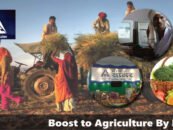Precision farming incorporates the strategic use of position, time and resources into all procedures connected to farming. It is a modern practice that uses technology to improve profitability and productivity for farmers. The concept uses remote sensing, Global Positioning Systems (GPS), and geographical information systems to monitor irrigation, crops, and soil. Precision farming is a solution for large-scale and mid size farms aiming to increase their existing production advantages.
Precision farming is accomplished through the use of analytical software and technical equipment. Soil testing, plot measurement, weather pattern analysis, and crop analysis are all done with precision using sensor-equipped devices positioned throughout the fields. The data is calibrated to draw conclusions, and a very specific and accurate set of practices can be implemented based on the findings.
One of the core applications of precision farming is in the area of site-specific applications of fertilizers. It enables you to get the best return on your inputs as the delivery of nutrients in specific combinations is done directly to the root of each plant. The amount and frequency can be changed to meet the needs of individual plants.
Predictive farming is similar to taking a medication to treat a certain condition. From the type of crop suitable for a plot to the usage of pesticides in certain areas, the solutions are highly personalized. Precision farming minimizes production costs and waste by catering to the specific needs of each plot.
The need for Precision Agriculture
India’s projected population for the year 2050 is 1.7 billion people, and the demand for food is going to increase by 70%. These numbers confirm the fact that more sustainable, eco-friendly practices are needed. To keep up with the growing demand for food, farmers will need more land and twice the amount of water, and both those resources are limited. To maintain the ample availability of food, farmers need to change the way they harvest. Conservation of land and water becomes necessary owing to the global demand for food, and precision farming comes into play here.
Agriculture in India alone consumes 80–90% of the freshwater withdrawals. Groundwater is depleting at an alarming rate, which would lead to critical problems in resource allocation in the future. To curb the problem, work needs to start now. Precision farming helps conserve depleting resources by making efficient use of water through precision farming solutions.
A farmer’s chances of producing good produce before the use of technology in agriculture were as good as tossing a coin and hoping for a winning outcome. Farmers were unable to learn the causes of crop loss because they lacked information about their fields. Farmers were pushed into losses and debt as a result of this approach. Big data analytics, IoT, and easily accessible satellite imaging have given the agriculture sector hope, reducing the issue of unpredictability.
Example of Precision Farming – Precision Fertigation
Precision fertigation means that the right amount of fertilizer is supplied at the right time to each plant. This maintains health and saves resources. Existing structures end up over-fertilizing growth sites because they do not consider the local limitations of the soil.
If nitrogen-rich fertilizer is supplied in excess, it not only ruins plant health but also contaminates groundwater.
The advantages of Precision Farming
The advantages include –
- Better Resource Management: More efficient use of water resources and less reliance on chemicals.
- Environmentally friendly: Prevents soil degradation, increases yield, conserves groundwater, and reduces nitrate leaching.
- Optimization: Large non-uniform fields can be subdivided into smaller plots with similar characteristics to sustain agricultural development and waste reduction.
- Forecasting: Farmers would be able to predict problems like water stress, nutrient deficiency, and pests.
Its disadvantages would include the high cost to farmers, the requirement for expert trainers, and the time taken to collect a large amount of data. It can take up to several years to collect data.
The main challenge to the adoption of the technique is the small size of landholdings. Farmers in India usually hold small pieces of land, and this technique is best suited for very large farms.
Companies like Trimble, Tata Kisan Kendra, and Fasal are working towards introducing the concept to Indian farmers.
The resources that help farmers adjust to precision farming
Precision farming focuses on lowering production costs and waste by catering to the specific needs of each plot. It focuses on farm-pIots data gathering and analysis, which includes sensors, drones, and robots for data recording, as well as software as a service (SaaS) that can be utilized to adapt to precision farming.
Despite the fact that IoT is still in its infancy, governments in agriculture-dominant nations are investing in cutting-edge technologies such as IoT, AI, and machine learning in order to develop better agriculture solutions. Implementing IoT in agriculture in Agri-based economies like India has its own set of benefits and problems. For starters, farmers are hesitant to upgrade to Agtech since they are unfamiliar with how technology may be used in agriculture.
Aside from that, the sensors, robots, and drones used in the development of IoT solutions are costly, require a lot of maintenance, and require technically trained personnel to operate. The information gathered must be analyzed, which can be done in a lab or on the farm using devices. In addition, a variety of sensors are required to collect data on various characteristics that must be analyzed independently, resulting in a large budget. As a result, the solution must be both cost-effective and scalable, taking into account the varying sizes of farms.
Way Forward
Precision Farming can revolutionize farm management, yielding not just more crops but better-quality crops. India must structure its infrastructure, policies, and budget to adopt the growing technology in agriculture.
Also, read on our portal, how sickle innovations is designing your farm equipment.






